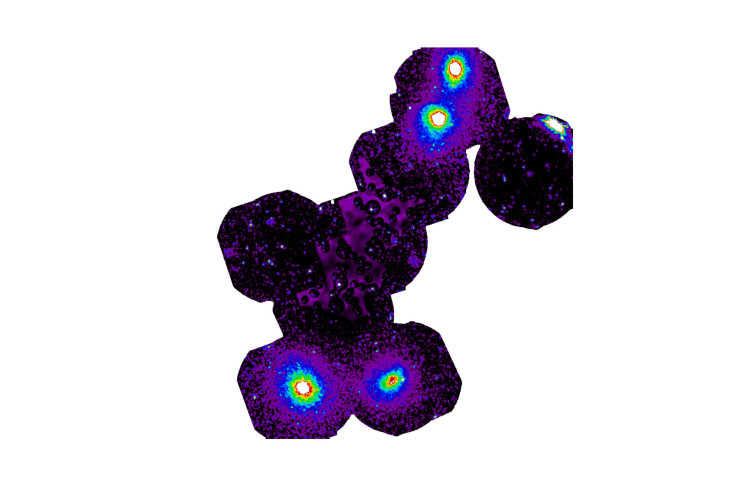The astronomers analysed a filament connecting four clusters of galaxies: A3532 and A3530 on one side and A3528-N and A3528-S on the other side. The clusters are part of the Shapley Supercluster, a large collection of more than 8000 galaxies located about 650 million light-years away from Earth in the constellation of Centaurus.
The analysis reveals that the filament consists mainly of free electrons and protons with a temperature of more than 10 million degrees Celsius. The density is about 10 particles per cubic meter. That is 30 to 40 times the average density of the universe. In total, the filament accounts for 1.2 x 10^13 solar masses of hot gas, or 10 times the mass of the Milky Way.
Elegant combination of methods
Hot gas in filaments was observed before, but it's the first time that its properties were determined with an accurate spectroscopic analysis, without significant contamination from black holes and galaxies. To pull off the contamination, the research team used an elegant combination of methods. First, with data from optical telescopes, they determined the orientation of the filament in the sky. Then, with the Japanese Suzaku X-ray space telescope, they obtained a spectrum of the whole region. After that, they used data from the European XMM-Newton telescope to model the contaminating black holes and cancel them out. Finaly, they could isolate a spectrum of the filament, which they used to determine its density and temperature.
The missing normal matter problem
According to observations a large part of the content of the universe is missing. There is the so-called dark matter, used to explain the relatively fast rotation rates of galaxies. And there's dark energy, used to explain the increasing expansion rate of the universe. But even a large part of the normal matter seems to be lost. The standard cosmological model predicts that about 30 to 40 percent of normal matter is difficult or impossible to detect with telescopes. Large-scale cosmological simulations show that this matter may be hiding in huge cosmic gas filaments connecting clusters of galaxies.
Early observations did not agree with simulations
Earlier, astronomers tried to 'stack' the observations of collections of filaments to overcome the contaminations by x-ray bright black holes. However, those stacked observations did not align with the predictions of the standard cosmological model.
"We did not expect that our new method isolated the signal of the missing baryons so effectively," says research leader Konstantinos Migkas, an Oort postdoctoral fellow at Leiden Observatory and SRON (Space Research Organisation Netherlands). "We now show that the properties of cosmic filaments agree with the simulations after all. So, it seems the cosmological simulations were right all along. That is a great reward."
According to Migkas and his the team, which includes members from the University of Bonn (Germany), the University of Helsinki (Finland) and the University of Paris-Saclay (France), the research could lead the way for future studies that search similar locations in the universe for filaments and their properties. It allows the researchers to better understand how the largest structures in the universe connect to each other.
Scientific paper
Detection of pure warm-hot intergalactic medium emission from a 7.2 Mpc long filament in the Shapley supercluster using X-ray spectroscopy. By: K. Migkas, F. Pacaud, T. Tuominen & N. Aghanim. In: Astronomy & Astrophysics, 19 June 2025. [original (open access, available after 19 June) ) | preprint (pdf)]
 Warm hot intergalactic medium exposed. A composite image based on X-ray data from the space telescopes JAXA Suzaku and ESA XMM-Newton. The filament with warm hot intergalactic medium is visible as a purple patchwork between the top two galaxy clusters (yellow dots) and the bottom two clusters (yellow and red dots). The gaps in the purple patchwork are places where X-radiation of black holes outshines the filament. They are subtracted to uncover the filament. (c) Migkas et al. [high resolution]
Warm hot intergalactic medium exposed. A composite image based on X-ray data from the space telescopes JAXA Suzaku and ESA XMM-Newton. The filament with warm hot intergalactic medium is visible as a purple patchwork between the top two galaxy clusters (yellow dots) and the bottom two clusters (yellow and red dots). The gaps in the purple patchwork are places where X-radiation of black holes outshines the filament. They are subtracted to uncover the filament. (c) Migkas et al. [high resolution]
